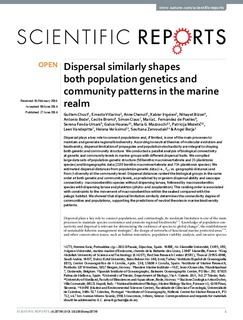| dc.contributor.author | Chust, Guillem | |
| dc.contributor.author | Villarino, Ernesto | |
| dc.contributor.author | Chenuil, Anne | |
| dc.contributor.author | Irigoien, Xabier | |
| dc.contributor.author | Bizsel, Nihayet | |
| dc.contributor.author | Bode, Antonio | |
| dc.contributor.author | Broms, Cecilie | |
| dc.contributor.author | Claus, Simon | |
| dc.contributor.author | Fernández De Puelles, Maria L. | |
| dc.contributor.author | Fonda-Umani, Serena | |
| dc.contributor.author | Hoarau, Galice Guillaume | |
| dc.contributor.author | Mazzocchi, Maria G. | |
| dc.contributor.author | Mozetia, Mozetič | |
| dc.contributor.author | Vandepitte, Leen | |
| dc.contributor.author | Verissimo, Helena | |
| dc.contributor.author | Zervoudaki, Soultana | |
| dc.contributor.author | Borja, Angel | |
| dc.date.accessioned | 2016-08-25T10:16:19Z | |
| dc.date.accessioned | 2016-09-21T12:59:59Z | |
| dc.date.available | 2016-08-25T10:16:19Z | |
| dc.date.available | 2016-09-21T12:59:59Z | |
| dc.date.issued | 2016-06-27 | |
| dc.identifier.citation | Scientific Reports 2016, 6:28730 | nb_NO |
| dc.identifier.issn | 2045-2322 | |
| dc.identifier.uri | http://hdl.handle.net/11250/2409373 | |
| dc.description | - | nb_NO |
| dc.description.abstract | Dispersal plays a key role to connect populations and, if limited, is one of the main processes to maintain and generate regional biodiversity. According to neutral theories of molecular evolution and biodiversity, dispersal limitation of propagules and population stochasticity are integral to shaping both genetic and community structure. We conducted a parallel analysis of biological connectivity at genetic and community levels in marine groups with different dispersal traits. We compiled large data sets of population genetic structure (98 benthic macroinvertebrate and 35 planktonic species) and biogeographic data (2193 benthic macroinvertebrate and 734 planktonic species). We estimated dispersal distances from population genetic data (i.e., FST vs. geographic distance) and from β-diversity at the community level. Dispersal distances ranked the biological groups in the same order at both genetic and community levels, as predicted by organism dispersal ability and seascape connectivity: macrozoobenthic species without dispersing larvae, followed by macrozoobenthic species with dispersing larvae and plankton (phyto- and zooplankton). This ranking order is associated with constraints to the movement of macrozoobenthos within the seabed compared with the pelagic habitat. We showed that dispersal limitation similarly determines the connectivity degree of communities and populations, supporting the predictions of neutral theories in marine biodiversity patterns. | nb_NO |
| dc.language.iso | eng | nb_NO |
| dc.publisher | Nature Publishing Group | nb_NO |
| dc.rights | Navngivelse-DelPåSammeVilkår 3.0 Norge | * |
| dc.rights.uri | http://creativecommons.org/licenses/by-sa/3.0/no/ | * |
| dc.title | Dispersal similarly shapes both population genetics and community patterns in the marine realm | nb_NO |
| dc.type | Journal article | nb_NO |
| dc.type | Peer reviewed | nb_NO |
| dc.date.updated | 2016-08-25T10:16:19Z | |
| dc.source.volume | 6 | nb_NO |
| dc.source.journal | Scientific Reports | nb_NO |
| dc.identifier.doi | 10.1038/srep28730 | |
| dc.identifier.cristin | 1375194 | |

